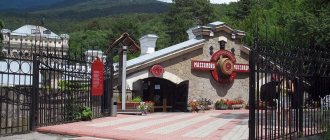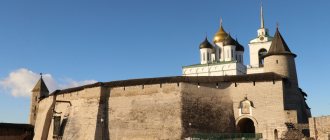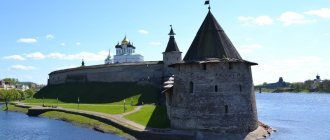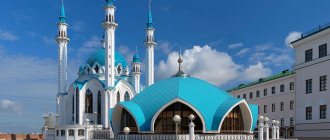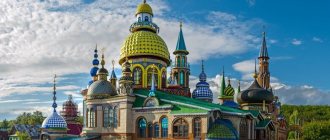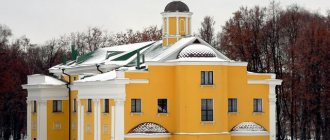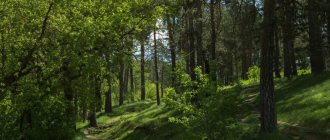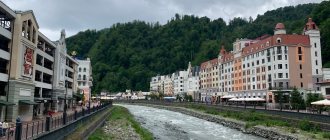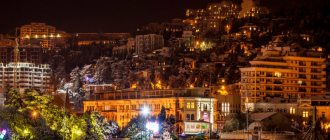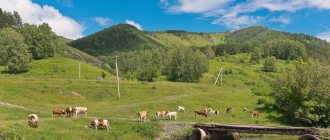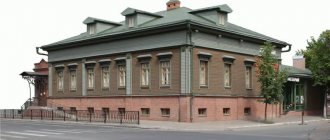Peterhof is perhaps the most famous suburb of St. Petersburg . As soon as it is not called: the Russian Versailles, the city of palaces, “the jewel in the crown of St. Petersburg,” the fountain capital of the world, an example of landscape art, and so on... The first mention of Peterhof dates back to 1705. What to see in Peterhof? lot of incredibly beautiful sights here , so it’s worth setting aside at least one full day to visit this amazing place.
During the Great Patriotic War, Peterhof was occupied by the Germans, who destroyed it almost completely. , more than 8 thousand exhibits and statues were evacuated . In the post-war years, a global reconstruction of the ensemble began, which continues to this day.
Peterhof is usually divided into Old and New . Old Peterhof is the western part of the city, where the estates of the Leuchtenbergskys and P.G. Oldenburgskys are located. New Peterhof is the eastern part, located between the Upper Garden and Alexandria Park.
What to see in Peterhof: 10 most beautiful sights
Large cascade of fountains, Samson fountain
Anyone who sees the 250-fountain Grand Cascade for the first time with its sculptural frame of 64 images and will not remain indifferent, because it is not just an object of art and some kind of aesthetic pleasure, but also a historical example of greatness and beauty, created by the artists and craftsmen of their time. The figure of “Samson” represents Russia, which defeated Sweden in the long Northern War, which allowed the country, under the leadership of Peter the Great, to reach the Baltic Sea and “cut a window to Europe.” Then Peterhof became an imperial residence, which was formed, designed and built by the best European and Russian architects following the model of the Versailles regular park. Today the Grand Cascade is the artistic embodiment of Peter’s dream of Great Russia, which he built and bequeathed to his descendants.
Dozens of gilded figures and a fountain extravaganza, making you forget about the bustle of the world, do not let you go and you want to immerse yourself again and again in the sound of water and the shine of drops on the gold of sculptures framed by the majestic buildings of the Great Peterhof Palace, rising on the terrace above the Great Cascade. It also contains grottoes, which in appearance cannot be distinguished from natural ones. The Great Cascade is fed from the Square Ponds of the Upper Garden thanks to an engineered water supply system that has existed for three centuries.
All this brilliance was created by various architects and sculptors: I. Braunstein, J.-B. Leblon, N. Michetti, M. G. Zemtsov, F. Vassu, K. Osner, among whom it is worth highlighting B. Rastrelli, who first created the figure of Samson in 1735. The hydraulic structures were carried out under the guidance of engineers P. Sualem, Tuvolkov, brothers Barratini. In 1802, sculptor M. Kozlovsky and architect A. Voronikhin created a new composition to replace the dilapidated one. In 1947, Samson was again put in his place by sculptors N. Mikhailov and V. Simonov, who created a copy from drawings and photographs. In 2011, the updated Samson, after restoration, again began to attract the attention of numerous visitors to Peterhof.
Sights of Peterhof
And now a little history. Petrodvorets was founded in 1710 and was intended as the main summer imperial residence . The idea of creating a country residence came from Peter I; he wanted it to be as luxurious as the French Versailles.
The surviving drawings of the tsar allow us to assert that the general concept of the layout, and in some cases the detailed design of some structures, belonged to the founder of Peterhof himself. The speed of creating the residence was amazing. Already in August 1723, the grand opening of Peterhof .
So what is it that captivates the imagination of Peterhof visitors?
The palace and park ensemble of Peterhof and its fountains
Not only the fountains are unique, but also the gravity water supply system, which has existed since the beginning of the 18th century. This is the world's largest system of fountains and water cascades . One of the largest architectural and fountain structures in the world is the Great Cascade of Peterhof - 250 sculptures and bas-reliefs, 80 fountains. In the center of the composition are two grottoes, on both sides of which there are waterfall stairs decorated with statues and vases.
The main fountain of the cascade is the Samson Tearing the Lion's Mouth fountain. During the Second World War, this sculpture was lost and restored from photographs in 1947 . The large cascade, as conceived by Peter I, symbolized the victory of Russia over Sweden (a lion is depicted on the coat of arms of Sweden) and served as the ceremonial end of the sea entrance to the residence.
What to see in Peterhof: the most beautiful sights 11
An interesting fact is that many of the craftsmen working on the ensemble had no idea what sea creatures looked like, so dolphins, for example, look more like fairy-tale fish.
Recently, the Upper and Lower Grottoes , created to strengthen the mountain on which the main fountain ensemble and the Grand Palace are located, have been open to the public. The interior decoration of the grottoes is unusual and beautiful; in tsarist times, hosts and guests rested here .
In the Lower Grotto there are “splash table” and “water curtains” joker fountains. The 12-meter wide Sea Canal begins from the Grand Cascade. There are 22 fountains along the canal, forming the so-called Alley of Fountains. Today, the Sea Canal and the Alley of Fountains are fully operational.
What to see in Peterhof: the most beautiful sights 12
The joker fountains of the Lower Park are very popular among guests . Funny fountains were installed by the will of Peter I. “Sofa” in the Monplaisir Garden, “Water Road” at the Roman fountains. Later, during the time of Catherine, the “Umbrella”, “Herringbone” and others fountains appeared.
Each fountain of Peterhof is a work of art and deserves a whole story; you can verify this during a personal visit. Of course, to enjoy the splendor of the fountains, it is better to visit Peterhof during the season when the fountains are operating. They usually open in mid-May and close in mid-October . It won't be difficult to check the schedule.
Great Peterhof Palace
The first two-story version of the Grand Palace was designed by J. B. Leblon, N. Michetti and I. Braunstein. Then it was called “Upper (mountain) chambers.” The width of the building at that time was equal to the Grand Cascade and was built from 1715 to 1725. In 1732, according to the design of M. Zemtsov, two galleries were added to the palace. The work was continued by B. Rastrelli in 1745-1755. The building became one floor higher and expanded along the terrace, bordering the Upper Park and the Lower Park. The Grand Palace was built in the style of “Russian” or “Elizabethan” Baroque, although initially it was more reminiscent of “Petrine Baroque”, like the Hermitage and Monplaisir palaces. The palace became the center of the Lower Garden, from which radial alleys radiate, designed by the master of landscape architecture J.B. Leblond, modeled on the parks of Versailles.
The splendor and luxury of the Baroque gave way to more austere decoration at the end of the 18th century. This was due to the fashion for classicism at the court of Catherine the Great. Many rooms of the palace were rebuilt in a new way: the Chesme Hall, the Dining Room, the Throne Room, the Chinese Cabinets (architect J. B. Vallin-Delamot). The interior decoration has undergone changes more than once. In the middle of the 19th century, the architect I. Stackenschneider created a project for the third floor of the Eastern wing, coming up with eight new interior options. Since this work was dedicated to the wedding of Nicholas I of Olga, half of the Grand Palace is still called Olginskaya.
The Grand Palace today has about 30 rooms and halls, many of which have been restored and are available for viewing by tourists. Here you can see with your own eyes the changes of eras, imagine how the royals lived with their entourage, how ladies and gentlemen from high Russian society danced at balls and walked along the palace.
Imperial Bicycle Museum
The sights of Peterhof are not only luxurious palaces and endless shady parks, but also numerous museums. One of them is the Museum of Imperial Bicycles, located in the oldest building of Peterhof. Unfortunately, it is not as popular as the famous Petrodvorets or the Grand Cascade, and visitors do not come here often. However, this is no less interesting.
There are only 12 exhibits on display at the museum - these are bicycles that once belonged to children and adult members of the royal dynasty. The exhibition tells the entire history of this vehicle from its inception to the beginning of the 20th century. Most of the exhibits are children's specimens. The collection is complemented by various accessories - lanterns, horns, cards with a picture of a bicycle, etc. The exhibition will be especially interesting to connoisseurs of Russian history.
View of the Gulf of Finland
For many tourists visiting Peterhof for the first time, the view of the Gulf of Finland from the coast of the Lower Park is a revelation. If the weather is good, the bay sparkles with small waves reflecting the sunlight. From here you can see the Marine Station on Vasilyevsky Island and the silhouettes of ships on the horizon. You can get to Peterhof by Meteor, a hydrofoil that takes you past the city traffic jams straight to the palaces and fountains. The only disadvantage of such a trip is the cost (750-800 rubles). But how many pleasant impressions there are from a boat trip!
The Gulf of Finland can be leaden, cold and uncomfortable, or it can be cheerful and kind, it all depends on the weather and your mood! After visiting historical attractions, many tourists happily sit down at the tables of a summer cafe near the Sea Canal and the Standart restaurant, where they can have a snack, eat ice cream or drink a cup of coffee. Other visitors to the park sit right on the shore and drink tea from thermoses, snacking on sandwiches.
Outdoor recreation in such a beautiful place is worth a lot! Children and adults always have lasting impressions. Standing on the shore of the Gulf of Finland, one can imagine cities and countries lying beyond the mirror of water and other people who also look into the distance through the waves, like Assol at the scarlet sails of Gray's ship.
Sightseeing tours to the best places
What to see in Peterhof - you know, it remains to figure out how to organize it. You can get there on your own, by train from the Baltic Station, by car or by minibus. But this is not as interesting as a professionally organized excursion with a good guide. Therefore, Sputnik offers the most convenient way to search for current trips.
Check out the list and choose the route to Peterhof that interests you. Book an excursion and pay for it directly on the website.
A couple of clicks - and you will find yourself in a city that has become an integral part of the historical and cultural heritage and popular excursion tours of St. Petersburg!
Monplaisir Palace and nearby fountains
This palace became the favorite brainchild of Peter the Great, because he not only rested and worked here, but also participated in its design. The project was implemented by outstanding architects: I. Braunstein, N. Michetti, J. B. Leblon, A. Schlüter. Famous artists and interior specialists worked inside the palace. Everything in the Monplaisir Palace is done functionally and very conveniently, which is what the emperor himself wanted. The second name of the palace, “Dutch House,” was given to it because of the facade, which is very reminiscent of the houses of the Dutch, as Peter I remembered them during his travels through Europe.
Next to the “Monplaisir” there is a composition with fountains and lead sculptures, created according to the design of Nicolo Michetti in 1723, but over time dilapidated and made by the sculptor I. Martos from bronze in 1817. The name “Bells” became popular due to the shape of the flowing water. pedestals of water jets. In the center there is a stone fountain “Sheaf”, along the circumference there are four more fountains with figures of Bacchus, Apollo, Faun, Psyche. These statues were buried during the Great Patriotic War, and after its end, they were restored and put back in their places.
How to get to Peterhof?
From 1944 to 1997 this suburb was called Petrodvorets . Peterhof is incredibly popular not only among tourists who come from all over the world to admire its splendor, but also among St. Petersburg residents. The most convenient way to get to Peterhof in the summer months is by high-speed ship Meteor , which departs from the pier opposite the Winter Palace. The journey will take no more than 30 minutes, during which you can enjoy the views of St. Petersburg and all the delights of a sea voyage.
You can also take the train , which leaves from the Baltic station every hour and will leave you at your destination in 40 minutes.
Avtovo metro station to Peterhof there are buses No. 200 and No. 210 and many minibuses. In general, there are many options, including personal vehicles .
Upper Garden
This is the most accessible corner of Peterhof, because a walk here is free, and the beauty of fountains and alleys, sculptures and ponds can detain a visitor for a long time, leaving no time for other attractions. The Upper Park was created simultaneously with the Lower Park and has approximately the same milestones in its history. This is the first layout under Peter the Great, the creation of ponds and water pipelines to feed the fountains of the Lower Park and the Grand Cascade by the outstanding hydraulic engineer P. Sualem, the layout of gardens and alleys, the design and construction of fountains, the installation of sculptural compositions.
In the Upper Garden (park) there are five fountains with the main one - “Neptune”. “Dubovy” and “Mezheumny” are also very famous, each of which has its own history. The layout of the Upper Garden as a French regular park was carried out by J. B. Leblon.
The fountains of the Square Ponds are decorated with sculptures “Summer” and “Spring”, and the statues of Neptune and Apollo Belvedere, created in 1736, bring masculinity to the ensemble of the Upper Park. Tourists love to see the sculptural group of gods and goddesses of the ancient Greek pantheon: “Zephyr”, “Pomona”, Vertumnus”, “Flora”, created by G. Bonazza in 1757. The sculptural composition of the Italian Venus with six dolphins adorns that part of the Upper Park, behind which the magnificent Peter and Paul Church, which is part of the Grand Palace complex, is visible.
What to see in Peterhof in one day
If you only have one day to visit Peterhof, most likely it will be completely spent in the fresh air. Even if you go around all the fountains in the morning (and the distances between them are large), the excess of impressions will not allow you to fully explore the museums. However, if you buy a ticket to the Grand Palace by two o'clock in the afternoon, you have a chance to join one of the excursions, get acquainted with the interiors in an accelerated manner and return to the fountains. The line at the ticket office may thin out closer to closing, so if a thorough inspection of the palace is not part of your plans, you can go for a run - you still can’t take photos inside.
It is better to view the fountains themselves clockwise, so you can walk to Alexandria Park, the imperial residence, especially since there is free entry after 5 pm.
When planning a trip to Peterhof, consider the size of the park and pavilions. Whatever you decide to devote your time to, you cannot do without a lunch break. The park has low-budget restaurants and fast food kiosks, where the queue is hardly less than the queue at the palace.
Grottoes of the Grand Cascade
The Lower and Upper Grottoes were built between 1716 and 1720 according to the design of architects J. B. Leblon, I. F. Braunstein, N. Michetti. These grottoes represent the center of the Grand Cascade; they are decorated with fountains, sculptures, and lined with tuff. A large grotto with a facade of five arches decorated with mascarons serves as the basis for a terrace leading to the Small Grotto. A marble balustrade with bronze tritons sitting on it serves as the border of the grottoes. The lower grotto is a hall with a high ceiling and a marble sculpture by P. Baratta, emphasizing the splendor of the room. There are also gilded copies of sculptures by ancient authors, created in the 19th century. There is a “Basket” fountain on the site.
By visiting the grottoes, you can learn the history of the creation of the Grand Cascade fountains, as well as the engineering solutions that are used here.
Church of Peter and Paul
The history of the Peter and Paul Cathedral in Peterhof is not as eventful as that of other architectural masterpieces, because this building was erected only at the beginning of the twentieth century at the request of the head of the clergy of the court, Ioann Yanyshev, who in time saw the need to build a new church in Peterhof due to lack of space in existing churches. After consideration of the request at the highest level, design (architect Nikolai Sultanov), laying the foundation, construction (led by architect Vasily Kosyakov), decoration and painting of the cathedral by the best artists of St. Petersburg and Palekh, 13 long years passed, and only in 1905 the temple was consecrated by the same protopresbyter John Yanyshev.
The history of the temple in Soviet times is a series of positive and negative events, thanks to which it still retained its original appearance. Today the cathedral is a functioning Orthodox church with a parochial school and its own charitable foundation. Its interior decoration is made in several artistic directions, but on the outside it is a typical architectural ensemble in the neo-Russian style, pyramidal and rising to the sky to a height of 70 m. Everything here is done rationally and functionally! The temple is surrounded by a covered gallery with interior spaces for the blessing of gifts. A vestibule was added as dressing rooms, and separate staircases ascended to the choir. The beautiful appearance is completed by a hipped belfry, a chapel with a stone arched portal, as well as two porches of the main entrance to the cathedral. Another frequently visited place in the temple is the observation deck, which can be accessed by paying a small amount as a donation. Most often, tourist groups following a specific excursion route are allowed onto the site. The view from the site in good weather is wonderful - this is Kronstadt, part of Peterhof with the Upper Park and Olga's Pond, part of St. Petersburg, Babigon, the Gulf of Finland.
Museum complex Islands
Address: Peterhof, st. Borodacheva Telephone: How to get there: You need to take a minibus or bus going to Peterhof (the numbers are indicated at the address of the Peterhof Palace and Park Ensemble), to the Torgovaya Ploshchad stop, then cross to the other side and follow along the Krasnoprudsky Canal to Tsaritsinskaya Street, then walk along Tsaritsinskaya Street until it intersects with Borodacheva Street and follow it until the entrance to the museum complex. Opening hours: daily 10:30-18:00, entrance to the museum until 16:45, ticket office open until 16:45 Cost: adult ticket 450 rubles, children under 16 years old free Entrance ticket to the park without visiting the Pavilions - 150 rubles. for all categories of citizens
Artificial islands on the Olga Pond of Peterhof were created by order of Nicholas I. According to the emperor's idea, the islands were to become secluded corners for his wife Alexandra Feodorovna and daughter Olga. The islands are cozy gardens on the banks of a pond with pavilions that are reminiscent of 18th-century villas and country houses in Southern Italy.
The Tsaritsyn and Olgin pavilions are located on the islands.
Architect Andrei Ivanovich Stackenschneider based the design of the Tsarina Pavilion on the appearance of ancient Roman houses discovered during excavations in Pompeii. The pavilion is an example of luxury. The garden contains many sculptures, a swimming pool with fountains, and the pavilion itself, a small one-story building with an attached three-story observation tower, is decorated with marble of different shades and polished stone.
Holguin Pavilion, built for the imperial daughter as a gift for her wedding day with Prince Charles of Württemberg, is made in the style of villas on the island of Sicily.
This is a three-story tower with a terrace and stairs going down directly to the water. In tsarist times, gondolas and boats moored here.
The facade of the pavilion is decorated with bas-reliefs, balconies, niches with marble busts, and water drains in the form of dragons. The garden is no less beautiful than the pavilion itself: the illusion of a Garden of Eden was created not only by numerous plants and flowers, but also by peacocks strolling through the park.
Inside, the decoration of the Pavilion is quite restrained, but no less beautiful. The upper terrace of the observation tower offers a picturesque view of Peterhof.
The park is closed in winter. The Islands museum complex opens to the public on May 27, 2022! The ticket price includes admission to both pavilions. The museum is closed during rain and high humidity.
Alexandria Park
Alexander Park of Peterhof began its development under Peter I, and later became Anna Ioannovna’s residence for hunting and entertainment. The park received the name “Alexandria” already during the reign of Nicholas I, who in 1825 gave this place to his wife, Empress Alexandra Feodorovna, as “Her Majesty’s own dacha Alexandria.”
Unlike other memorable places in Peterhof, “Alexandria” has an unusual architectural appearance. Everything here is permeated with neo-Gothic style, even the Orthodox Church of Alexander Nevsky looks like a Gothic chapel. All buildings were designed and executed by architects A. Menelas, A. I. Stackenschneider, K.F. Schinkel in the 30s of the 19th century by order of the imperial family. Today here you can see a number of buildings in the neo-Gothic style dating back to the mid-19th century: the Palace Telegraph Station Museum, the Farmers' Palace, the Chapel with 43 bronze statues (sculptor V.I. Demut-Malinovsky), the Feldjeger House, the Sea Guard, the Palace " Cottage". The Great Ruin Bridge, which is so called because of the ruins of Alexander Menshikov’s palace “Moncourage” that was once located here, is interesting, as well as the “Pergola” bridge, which means “canopy from the sun.”
Nowadays, “Alexandria” serves as a family park, where St. Petersburg residents and guests of the city like to relax, since there are few tourists here compared to the Nizhny Park.
Bath building
In the form in which it exists now, the Bath building was built under Elizaveta Petrovna. In the old days there were steam rooms, showers and bathrooms here. A variety of bath utensils shows how important hygiene and cleanliness of the body were for Russian people.
Throughout its existence, the bath building was repeatedly refurbished to suit the needs of each successive ruler. Today it is the second most popular place among tourists after Petrodvorets.
Cascade "Chess Mountain"
The cascade, which is called “Chess Mountain” because of the checkerboard pattern of the steps, is located on the most beautiful square in the eastern part of the Lower Park. The cascade is a natural slope of the terrace bordering the Lower Park. Architects I. Braunstein, M. Zemtsov, T. Usov, I. Blank, I. Davydov had a hand in the construction of this cascade. Initially, the cascade was planned as a destroyed fortress tower, then it began to personify the home of the winged dragons that guarded the entrance to the Upper Grotto. Then it began to be called “Dragon Mountain”. “Chess Mountain” is decorated with sculptures of ancient gods, preserved in the ground during the Great Patriotic War. Already in 1953, the cascade was restored and became again similar to the previous one.
Fountains - firecrackers
“Yolochki” - built in 1784 according to the design of architects I. Keizer and F. A. Strelnikov. “Christmas trees” are three metal trees, very similar to real firs, located next to the Greenhouse. In 1951, the firecracker was recreated by a team of fountain master A. Smirnov.
“The Oak” is a joke fountain created in 1735 according to the design and model of B. K. Rastrelli. At first it decorated one of the pools in the Upper Garden, but in 1802 the master F.A. Strelnikov installed the “Oak” not far from Monplaisir Alley, where it is located now. Today, the joke fountain “Dubok” is a real fountain complex of several water extravaganzas, which include a metal trunk, 500 branches-tubes and 2500 leaves. In the post-war years, it was restored using archival documents and one branch with leaves by the masters Lavrentiev (father and son).
The “umbrella” was created as a water cracker in 1796 by the architect F. Brower. The fountain looks like an umbrella and therefore has this name. As soon as the guests gathered under its roof, streams of water began to flow from 164 pipes, hidden behind carved festoons and providing a dense curtain of water. In the 19th century, the fountain began to look like a fly agaric and it was called “Mushroom”. In 1949, restorers decided to return the name “Umbrella,” but many native St. Petersburg residents still call this cracker “Mushroom.”
The “Water Road” is located on Monplaisir Alley next to the Roman fountains. This joke fountain has not worked for 280 years, since the reign of Peter the Great, when, by his decree, the architect N. Michetti created the “Water Road”, first launched in 1721. The idea was interesting: 300 water jets suddenly began to shoot from both sides of the path and all those walking were caught in a firecracker shower. Under Peter, this fountain was called the “Mochilnaya Road”. The fountain was restored according to the surviving drawings and descriptions in our time and now it works strictly according to the schedule: 13.00, 14.00, 15.00.
“Sofas” is a joke fountain that began its existence in 1723 according to the design of N. Michetti. This fountain is a trellis structure with lattice legs and backs, on which are mounted triton mascarons, modeled on decorative sculptures of the early 18th century. When approaching the “Sofas” you need to be prepared for the fact that jets of mascaron and a tuff slide under the seat will fall on you, as well as streams of water from tubes built into the area near the “Sofas”. This is the most favorite joke fountain among children visiting Peterhof.
Peterhof Palace and Park Ensemble
Basic moments
If you get to Peterhof on the Meteor, then from the pier you go straight to the Lower Park. If you come by land, then first you will see the Upper Garden - don’t miss the opportunity and go into it, it’s small (only 15 hectares)
, but very beautiful. It has five fountains, the most impressive of which is . Covered alleys covered with greenery stretch along the garden fence.
Entrance to the Upper Park is free, but you will have to pay for the pleasure of admiring the fountains of the Lower Park, regardless of which side you enter it from. There are ticket offices at all entrances, including the pier.
Peterhof was founded at the very beginning of the 18th century. Emperor Peter I as a majestic monument glorifying Russia's victory in the struggle for access to the Baltic Sea. This is the most luxurious summer royal residence. The enchanting spectacle of many playing water cannons made it world famous. In the summer, the park is simply crowded, especially on weekends.
The main attraction of the park is a unique fountain system created in the times of Peter the Great under the leadership of the first Russian hydraulic engineer Tuvolkov. It is often compared to Versailles, but in some respects it is even superior to its French counterpart.
Peterhof fountains operate on the principle of communicating vessels due to differences in relief heights and do not require special pumping of water. The fountains and cascades are fed by fresh water coming from the Ropshinsky Heights springs through a 22-kilometer gravity water pipeline.
The lower park stretches along the coastal strip for 2 km and covers an area of 102 hectares. What gives it a special identity is the proximity of the sea, with which it is so organically connected. The Gulf of Finland is connected by a specially dug Sea Canal to the Grand Cascade - the largest fountain structure in the world, including 75 fountains and about 250 sculptures and decorative ornaments.
Waterfalls, water cannons, gilded statues, bas-reliefs, vases, balustrades, the incessant sound of water - all this amazes with its magnificence and creates a solemn and festive mood.
The Grand Cascade is especially beautiful on holidays, when it becomes a platform for magnificent costumed performances framed by many crystal streams of water, accompanied by light and music effects and fireworks.
In 1735, in honor of the 25th anniversary of the Poltava victory of Russia over Sweden, the sculptural group “Samson tearing the mouth of a lion” was installed at the Grand Cascade. Samson here symbolizes victorious Russia, and the lion allegorically depicts Sweden. A stream of water escaping from the lion's mouth rises to a height of 20 m.
There are 22 fountains along the Sea Canal - this is the so-called Alley of Fountains. And along the canal, by the way, in the times of Peter the Great, high-ranking guests could travel by ship to the palace itself.
There are three more impressive cascades in the park - "Chess Mountain" ("Cascade of Dragons")
in the eastern part of the park and two in the western - Marlinsky
(“Golden Mountain”)
and Lion Cascades.
In addition, in the Lower Park you will find many magnificent fountains, the most famous of which are “Pyramid”, “Sun”, “Adam” and “Eve”.
The Lower Park is also famous for its joker fountains, which can easily douse an unlucky visitor with water. If you want to see their action, go to the eastern part of the park, where metal fir trees, oak and tulips await you, spraying jets of water in all directions, the “Umbrella”, which showers everyone, as well as seemingly ordinary-looking park benches , it is unsafe to pass in front of them - a thick canopy of sparkling jets may unexpectedly fly out from behind their backs. Such “wetting games” were very popular in the 18th century.
Not so long ago, another entertainment from Peter’s times was revived - the “Water Road”. According to the king’s idea, the whole alley was to be blocked by a water arch, and all those walking would be wet from head to toe. And now, in the summer, three times a day at 13.00, 14.00 and 15.00, three hundred inclined jets, rushing towards each other from one side and the other of the alley leading from Chess Mountain to Monplaisir, form a “water road” to the delight of enthusiastic visitors. Children, of course, especially like joke fountains, so if you are going to Petrodvorets with a child, take a towel and a change of clothes with you so that the trip does not end with a cold.
In Peterhof museums you can see posters with a funny, but relevant warning in this place: “Visitors in wet clothes are not served.” And you can visit a lot of interesting things here - from the Grand Imperial Palace to the museum of royal bicycles or bird aviaries. In total, there are more than 20 different museums in the Peterhof Reserve.
The majority of visitors strive to get to the Grand Palace, which is not so easy to do in the summer season due to the huge influx of people who want to see it, creating long queues. Please note that although the palace is open from 10.30, in the high season, booked foreign groups are allowed into it in the morning, and Russian tourists with tickets usually begin to enter from 12.00. In winter, the fountains do not work, the park is practically deserted, and you can get into the palace at any time without any problems.
In the Lower Park there are two small pavilions-aviaries in which birds were kept in tsarist times. They are twelve-sided pavilions, topped with domes and lanterns, and their walls, lined with tuff and shells, are almost entirely occupied by wide, finely glazed windows. Now the tradition of keeping birds in enclosures has been restored, and visitors to the park have access to what they saw and heard here, for example, the guests of Empress Elizabeth Petrovna in the mid-18th century. Overseas birds, which were customary to be bred three hundred years ago, are once again living in cages made from ancient engravings. For them to sing, silence is needed, so 5-6 people are allowed inside. To enter, you need to “bow” to the birds: since the Peter the Great era, the door to the aviary has been very low.
Another interesting opportunity is to visit the Great Grotto of the Grand Cascade on a guided tour. To do this, you must purchase a ticket at the ticket office located on the upper terrace. When the group gathers, the tourists descend into the dungeon under the palace terrace.
This is only part of the possible pastime in Peterhof. In addition, you can visit the Peter the Great's palaces of Marly and the Hermitage, located in the western part of the park, or go to one of the many local museums.
While in Peterhof, do not miss the opportunity to visit the most beautiful temple in the neo-Russian style - the Cathedral of the Holy Apostles Peter and Paul (St. Petersburg Ave., 32)
. The cathedral was erected in 1905 by architect Sultanov. The uniqueness of its design is in the five-domed tent structure and the covered gallery encircling the building. The cathedral is active, admission to it is free, and for a small donation you will be given the opportunity to climb the stairs to the upper gallery, which offers stunning views of the surrounding area.
On one side there will be parks and the sea, and on the other you will see Olgin's pond with two islands - Olgin and Tsaritsyn with beautiful pavilions. You can visit them too.
Another interesting Peterhof park is Alexandria. It is located immediately behind the Lower Park towards St. Petersburg (open daily from 09.00 to 22.00, in winter until 19.00, admission in summer - 50 rubles, on weekends - 70 rubles, reduced price - 30 rubles, foreigners - 100 rubles, foreign students - 50 rubles .)
.
This is the former summer residence of Emperor Nicholas I, named after his wife Alexandra Feodorovna. Work on its construction began in 1826, when the Tsar ordered the construction of a “rural house” called the Cottage. In this comfortable, bright, elegant and cozy house, conveniently located on a hill and surrounded by a landscape park with shady alleys, winding paths, lawns and groves, the ideas and dreams of the “Peterhof landowner” (as Nicholas I called himself)
and his romantically minded wife .
In addition, in Alexandria Park you can visit the recently restored Gothic Chapel, the Farmers' Palace, and the Palace Telegraph Station.
Since June 2010, after a long restoration, the Farmers' Palace has been open to visitors in Alexandria Park. It was erected in 1831 according to the design of the architect A. Menelas, and then completely rebuilt by A. Stackenschneider for the future Emperor Alexander II and his young wife Maria Alexandrovna. After alterations, the former park pavilion with a farm turned into a real summer country residence, where the king could retire and fully relax with his family. Here he worked on important documents, met with advisers, and, in particular, it was here that meetings were held to prepare the peasant reform.
In addition to these parks, Peterhof also has the rather abandoned Lugovoi (where the Belvedere Pavilion was recently restored and turned into a hotel)
, Colonial, English, Alexandrinsky.
You can walk around Peterhof all day, and you are unlikely to have any energy left for anything else.
Great Peterhof Palace
The Grand Palace rises solemnly on a steep ledge above the Lower Park. An elegant building with galleries and sparkling gilded domes of the side buildings stretches its facade along the upper terrace for almost 300 m. Architects Braunstein, Leblon, Michetti, Zemtsov worked on its creation, and under Empress Elizabeth it was rebuilt by the outstanding Baroque master Rastrelli, who, giving free rein to his creative imagination, decorated the premises with fabulous luxury. Under Catherine II, some of the halls were re-decorated in the classical style by the architect Felten.
Until 1917, it was the ceremonial summer residence of the imperial family; official receptions, magnificent balls, and important celebrations were held here. The luxurious interiors of the palace, preserved from Rastrelli, are very beautiful: gilded wooden carvings flowing around numerous mirrors, silks on the walls, inlaid parquet floors. At the end of the visit, you will find yourself in the Oak Study of Peter I, which stands out in sharp contrast against their background - the walls here are covered with carved wooden panels, amazing with the jewelry carving technique.
In the halls of the Great Peterhof Palace you can see ceremonial portraits of Russian emperors, paintings glorifying the victories of the Russian fleet, rich collections of antique porcelain, furniture and artistic bronze. The palace, like the park, was very badly damaged during the Great Patriotic War (Peterhof ended up on the front line)
and was revived by the hands of talented restorers.
If the queue at the Grand Palace scares you, go to other Peterhof museums, where you can also see a lot of interesting and unique things. For example, instead of crowding at the main entrance to the palace, walk along its facade to the left (if you are facing the sea)
and enter another door located almost at the exit from the park. There is a building under the coat of arms, in which a special storage room is open to visitors.
On the other side of the palace is the Church Building with its five gilded domes, recently restored. Since 2011 it has also been opened to the public.
The Lower Park also has many interesting and accessible small palaces and pavilions. We especially recommend taking a look at the favorite palace of Peter I - Monplaisir. It is located on the seashore in the eastern part of the Lower Park.
A unique museum of ancient life is the Bath Building, built in the 19th century. near Monplaisir.
On the other side of Monplaisir is the Catherine Corps.
The three buildings mentioned above form the elegant Monplaisir Garden, protected from the sea winds, with bright patterned parterres and five fountains.
- Razvodnaya st., 2
- Tel. 450-52-87, 427-74-25
- Open daily, except Mon, from 10.30 to 18.00, in the summer until 19.00 (ticket offices close an hour earlier)
. The last Tuesday of each month is sanitary day - Inspection - 1 hour. Entrance - 280 rubles, preferential (including schoolchildren)
- 140 rubles. For foreigners, full - 520 rubles, preferential - 250 rubles.
Church building
In the recently restored palace church, designed by F.B. Rastrelli, you can admire the magnificent six-tiered iconostasis with twisted columns and the monogram of Empress Elizabeth Petrovna, elegant gilded carvings and picturesque paintings of religious subjects, as well as see icons of the 18th-19th centuries, items of ceremonial vestments of clergy and ancient church utensils.
- St. Adjustable, 2
- Tel. 427-74-25
- Open daily, except Monday and Tuesday of the last month from 10.30 to 18.00. The cash desk is open until 17.00
- Entrance - 200 rubles, reduced price - 100 rubles. Foreigners - 350 rubles, preferential - 200 rubles.
A special storeroom in the Corps under the coat of arms
Here you will have a unique opportunity to see the chambers of Catherine II, as well as the personal belongings of the rulers of Russia, from Peter I to the last Russian emperor Nicholas II. Coronation and award items, ceremonial dishes made of silver and gold, precious snuff boxes, a rare collection of miniatures with portraits of emperors, diamond brooches and earrings, porcelain, ancient shiny uniforms, luxurious ball gowns, fans, mirrors, toiletries, and famous items are on display here.
- St. Razvodnaya, 2 (in the building under the coat of arms)
- Open daily, except Monday of the last Tuesday of the month, from 10.30 to 18.00. The cash desk is open until 17.00
- Inspection - 30-40 minutes. Entrance - 200 rubles, discount - 50 rubles. For foreigners, full - 500 rubles, preferential - 200 rubles.
Monplaisir
This small building on the shore of the Gulf of Finland was the first building of Peterhof. Its name translates as “my pleasure.” Peter I loved Monplaisir very much and almost always stayed there during his visits to Peterhof. “Even when he visited Peterhof in the summer,” wrote the Holstein envoy to the Russian court, Count Bassevich, “the air of the vast gardens of that palace seemed suffocating to him, and he always slept in Monplaisir.” As he fell asleep, he heard the splashing of the waves; when he went out onto the terrace during the day, he could see Kronstadt and St. Petersburg. Celebrations and receptions of official guests were held here in the central main hall. It is interesting to look at Peter’s bedroom, his office, kitchen and the exotic Lacquer Cabinet, decorated in a bright oriental style, where about 150 vases and cups made of the most valuable Chinese and Japanese antique porcelain stand on carved gilded shelves.
- The museum is open only in summer except the last Wednesday of the month, from 10.30 to 18.00
- The ticket office closes an hour earlier
- The museum is closed during rain and high humidity
- Inspection -20 min. Entrance - 150 rubles, reduced price (including schoolchildren)
- 80 rubles. For foreigners, full - 360 rubles, preferential - 180 rubles.
Bath building
The building was built as a bathhouse with a complex of therapeutic and hardening baths for Empress Maria Alexandrovna, wife of Alexander II, who suffered from an incurable disease at that time - consumption. The heavy St. Petersburg air was harmful to her weak lungs, and in the summer she went to Peterhof, since the fresh maritime climate combined with the dense greenery of the park was considered beneficial to her health. Here you can see cold and warm bathrooms, a steam room, and also visit the Assembly Hall, the Cookery and Tafeldekerskaya with Kofishenskaya. In a cold bathroom, be sure to pay attention to the original chandelier, which also served as a shower.
- During the summer, the museum is open daily, except Wed, from 10.30 to 18.00
- In winter, open only on weekends from 10.30 to 17.00
- The ticket office closes an hour earlier
- The museum is closed during rain and high humidity
- Inspection - 30-40 minutes. Entrance - 150 rubles, reduced price (including schoolchildren)
- 80 rubles. For foreigners, full - 360 rubles, preferential - 180 rubles.
Catherine's building
This building is called the Catherine Corps, because it was from here that on June 28, 1762, Catherine II secretly went to St. Petersburg, where she led a conspiracy aimed at overthrowing her husband Peter III from the throne. Having gained power, the new empress used this building for ceremonial dinners and annual balls for graduates of the Smolny Institute, which she founded. Gradually, the Catherine Corps turned into a palace-museum of the late 18th - early 19th centuries. Furniture, mantel clocks, candelabra, vases - everything corresponds to the classical architectural decoration of the halls and is distinguished by its noble forms and lines.
- Open daily in summer, except the last Thursday of the month, from 10.30 to 18.00
- In winter, open only on weekends from 10.30 to 17.00
- The ticket office closes an hour earlier
- Inspection - 30 min. Entrance - 200 rubles, reduced price (including schoolchildren)
- 100 rubles. For foreigners, full - 360 rubles, preferential - 180 rubles.
Excursion “Grottoes of the Grand Cascade”
This excursion will give you the opportunity to visit under the Great Cascade - in the Great Grotto, decorated with tuff stone and gilded sculptures, where noble visitors gathered in the times of Peter the Great. The idea of its creation belonged to Peter I himself. Even on the hottest day, coolness reigns there, and a large vase with a pyramid of fruit on a stone table looks especially tempting. But as soon as you reach out to them, water jets fly out of inconspicuous holes around the circumference of the table. This is another Peterhof joker fountain. In addition, the guide will show you the winding fountain pipes and tell you about the ingenious design of the local water pipeline. At the end of the excursion, you will leave the grotto right in the middle of the Grand Cascade and find yourself among the jets noisy from all sides.
- Excursions are held daily in the summer from 11.00 to 18.00 (on weekends until 19.00)
- Duration - 30-45 minutes
- Ticket - 200 rubles, reduced price - 100 rubles. For foreigners - 300 rubles, preferential - 150 rubles.
Marley
Marly is a palace located in the western part of the Lower Park of the Peterhof palace and park ensemble. The exposition of the Marly Palace presents unique exhibits: a naval overcoat of Emperor Peter I and a caftan with an embroidered Order of St. Andrew the First-Called, books from his library, a table with a “slate” board made by the hands of the tsar, his personal dishes. The collection of paintings collected by the emperor is also presented here, which forms the basis of the picturesque exposition of the palace. It includes works by little-known Dutch, Flemish and Italian masters of the 17th-18th centuries: A. Silo, A. Stork, P. Belotti, A. Celesti, etc. Some furnishings are authentic, others are carefully selected by analogy, in accordance with surviving documents.
The westernmost part of the Lower Park is occupied by the Marlinsky Garden, divided by the Big Pond into the Bacchus Garden (located south of the pond)
and the Garden of Venus
(located on the north side, closer to the sea)
. The gardens were laid out simultaneously with the construction of the palace and had a utilitarian significance. In the garden of Venus, fruits were grown for court meals. The name of the Bacchus Garden is transparent: under Peter I they tried to grow grapes here, but unsuccessfully. The Garden of Venus is protected from the winds from the Baltic by an earthen rampart, poured during the laying of the ponds.
On the eastern side of the Marly Palace is Marlinsky, and on the western side are Sector Ponds. Their purpose was not only decorative: the ponds contained fish for the royal table, brought from various parts of Russia, and from 1724 they began to breed them here. Marlinsky ponds are a kind of active monument. The tradition of raising fish has been resumed in our time, and fishing lovers can spend their leisure time in Marly doing their favorite pastime.
- Open in summer every day except Mon from 10.30 to 17.00
- The ticket office closes an hour earlier
- Entrance - 100 rubles, reduced price 50 rubles. Foreigners - 150 rubles, preferential - 100 rubles.
Hermitage
The Hermitage in Peterhof served as the prototype for all Russian “hermitages” built in the 18th century.
The construction of the Hermitage was carried out according to Braunstein's design in 1721-1725. The two-story Hermitage building, 11 meters high, stands on a solid massive stylobate, emphasizing its lightness and grace. The pavilion is surrounded by a deep and wide ditch, the walls of which are made of brick and bordered by a curb of light stone. The ditch was filled with water, and a drawbridge was thrown across it.
A distinctive feature of the Hermitage are the windows and glazed doors that occupy most of the facades. As a result, the second floor seems almost transparent, and the entire pavilion resembles a crystal box.
The pavilion was intended for entertaining and secluded pastime of people from the inner circle of the “royal person.” Important state affairs were discussed in the Hermitage. The Hermitage Hall served as a literary salon.
On the ground floor of the Hermitage there was a vestibule, a kitchen and a pantry with a lifting table mechanism. Behind the oak partition there was a staircase to the second floor. The second floor consisted of one hall of 80 square meters.
Of particular interest was the engineering design of a lifting table for 14 people, which made it possible for nobles to dine without the presence of servants.
- Open in summer every day except Tuesday from 10.30 to 18.00
- In winter, open only on weekends from 10.30 to 17.00
- The ticket office closes an hour earlier
- The pavilion is closed during rain and high humidity
- Entrance - 100 rubles, reduced price -50 rubles. Foreigners - 150 rubles, preferential - 100 rubles.
- The main ancient “undertaking” of the Hermitage - the recently restored unique lifting table - can be seen in action on weekends at sessions of 13.00, 14.00, 15.00. Special prices apply for these sessions.
Cottage
Everything here is imbued with the spirit of neo-Gothic. Pointed arches of balconies, masterly carving of window and door slopes, screens and chairs in the Gothic style, bright plates with stained glass patterns, a collection of table clocks in the form of Gothic cathedrals - such medieval details look very unusual against the background of bright rooms entwined with greenery. Gothic decor is repeated in handmade carpets, the decor of stoves, marble fireplaces, and candelabra. By the way, you might have seen this palace in the film “The King of Blackmail” from the famous series about Sherlock Holmes.
- Alexandria Park
- In summer, open daily, except Mon, from 10.30 to 18.00
- In winter, open only on weekends from 10.30 to 17.00
- The ticket office closes an hour earlier
- Inspection - 45-60 min. Entrance - 200 rubles, preferential (including for schoolchildren)
- 100 rubles. For foreigners - 300 rubles, preferential - 150 rubles.
Holguin and Tsaritsyn pavilions
Olga's pond was dug in 1838 by order of Nicholas I on the site of a former swamp. It was filled with water from the Ropshinsky springs, and to this day it serves as a pool feeding the eastern group of fountains in the Lower Park. Two islands were formed from the excavated earth - Tsaritsyn and Olgin. On the islands, according to the design of the architect Stackenschneider, pavilions were built for the wife and daughter of Nicholas I.
The Tsaritsyn pavilion was built as a pleasure palace in the then fashionable “Pompeian spirit”; the Olga pavilion was built in the style of a southern Italian villa. The islands amaze with the abundance of flowers, sculptures, marble benches, ruins reminiscent of the wreckage of an ancient building, fountains, and pergolas. Stepping onto their territory, it seems that you have been transported from the cold north to warm Italy, the land of dreams and dreams.
- Colonial Park of Peterhof
- Open only in summer, daily from 10.30 to 18.00
- Inspection of the pavilions only with a guided tour (groups from 6 to 12 people)
, duration - about 2 hours. - There are no excursions during rain
- Entrance - 300 rubles, reduced price - 100 rubles. For foreigners - 540 rubles, preferential - 270 rubles.
Gothic chapel
The Gothic Chapel is the home church of the royal family, built in honor of Alexander Nevsky. The small building with rose windows for stained glass and lancet portals is decorated with cast iron lace of Gothic ornament. Despite its appearance, it is an Orthodox church with a carved gilded iconostasis. Here, members of the royal family prayed before important events in their lives, and here the ladies-in-waiting of Empress Alexandra Feodorovna were married.
- Alexandria Park
- Open only in summer every day except Mon from 10.30 to 18.00
- The cash desk is open until 17.00
- Inspection - 15-20 minutes. Entrance - 100 rubles, reduced price - 50 rubles. For foreigners - 140 rubles, preferential - 70 rubles.
For visitors
- Tel.: 450-52-87, 427-74-25
- The lower park is open from 9.00 to 19.00 (in summer until 20.00)
- A full ticket on weekdays costs 150 rubles, a discounted ticket (students and pensioners)
costs 80 rubles.
On weekends, a full ticket costs 250 rubles, a discounted ticket (students and pensioners)
costs 100 rubles.
Children of preschool age are free. For foreigners -400 rub. (full)
, 200 rub.
(preferential) - The fountains are open from May to early October from 11.00 to 18.00 (on Sat, Sun and holidays - until 19.00)
How to get there
There are different ways to get to Petrodvorets, located on the southern shore of the Gulf of Finland. The shortest and most impressive is on the high-speed Meteor on the water. It will only take half an hour. Naturally, this is only possible during the navigation period (from May to September)
. “Meteors” depart from the pier located on the Palace Embankment opposite the Hermitage, as well as from the pier near Senate Square, and moor to the pier in the Lower Park of Petrodvorets. Disadvantages: traveling this way will cost you the most, flights may be canceled in bad weather. Different companies transport passengers on Meteoras, so prices vary: adults one way - about 500 rubles, children one way - about 300 rubles. When purchasing a round-trip ticket, the trip is cheaper.
Cheaper ways are train or bus (minibus)
.
If you choose the railway, then you need to go from the Baltiysky station (Baltiyskaya metro station)
to the New Peterhof station. The journey takes approximately 45 minutes. Unfortunately, the beautiful neo-Gothic train station of the New Peterhof station, similar to Westminster Abbey, is located quite far from the park, and you will have to go there by bus No. 344, 348, 350, 351, 352, 355, 356, about 10 minutes. They depart from the square in front of the station.
It is more convenient to take the metro to the Avtovo station, cross the road and take bus 200, 210 or minibus No. 224, 300, 424, 424a, which will take you directly to the entrance to the park. Route taxi No. 420, 103 goes there from the Leninsky Prospekt metro station.
By car you should leave St. Petersburg along Stachek Avenue through Avtovo and then along the Peterhofskoye Highway, which runs along the southern shore of the Gulf of Finland. Petrodvorets is located 29 km from St. Petersburg. About a kilometer and a half after entering it, there will be a park on the right side. The journey from the city center takes about an hour.
